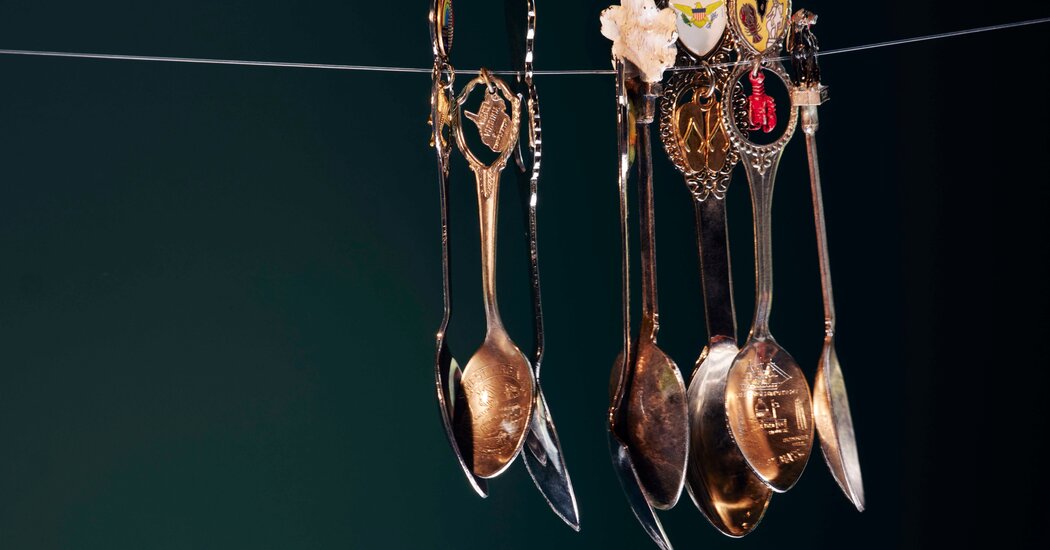I Collect Souvenir Spoons. I Can Explain.

For three years in the 1980s, my father, who was a partner at a class-action securities firm that bore his name, had an ongoing legal case in Oregon. As a child, I had no idea what this meant, only that he often returned to New York from his long business trips with two things: a stupid dad joke, and a tiny spoon, purchased in the gift shop of an airport. An afterthought, sure, but it was something. We were almost always apart, my father and I, from the time I was 1, when my parents separated, to the time he died, when I was 30.
But spoons were always arriving, for most of my childhood — souvenirs I wanted badly, almost as badly as I wanted to be alongside him on his journeys. There was the trip my father and stepmother took to Hawaii with one of my younger sisters. There was, too, his solo white-water-rafting adventure in Arizona; he kept his own souvenir, a photograph, from that trip in his trim office, where, by day, he was a clean-shaven attorney, and by night, the kind of man who departed for weeklong forays down the Colorado River. From his second honeymoon, in France, he brought back a spoon adorned with a petite replica of the Eiffel Tower.
Later, other people brought me spoons. My stepmother’s father, Irving, who retired from the Postal Service, started a second unofficial career as a world traveler, which is how I came to own spoons from airports in Israel, China, Japan and, when it still existed, Yugoslavia. At my father’s house, in Westchester, more than 200 miles from where I lived with my mother in northern Massachusetts, the spoons hung in curio cabinets on the walls of my bedroom until I went to college. Then they were stored away in a closet until I stopped collecting, and they grew dusty. I forgot about the places I had never been to, and flew off to actual, real-life places.
In the United States, souvenir-spoon-collecting dates back to the mid-1800s (the first American souvenir spoon, produced in the late 1800s, was outfitted with George Washington’s profile). By the time the Chicago World’s Fair arrived, in 1893, with its 27 million visitors, spoon-collecting had become a pastime. It’s impossible to say what people collecting spoons a century ago were thinking, but I like to imagine that then, too, it was a form of aspirational travel, carried out through gifts from friends and family. Perhaps those armchair travelers may have been no different from the toddler waiting at home for her spoon to arrive, and for the world to unfold through the magic of finely etched silver or nickel. I felt then, as I do now, that these spoons, with their careful embellishments, displayed a level of artistry that other keepsakes couldn’t match. I loved the scalloped edges on the Windsor spoon and the motorcar atop the one from Detroit — details that brought me joy in a way that a gift-shop shirt or a vial filled with pink sand from some tropical beach never did.
From 1988 to 1998, I flew between Boston’s Logan Airport and New York’s LaGuardia every other weekend, a regular route carved into me by divorce. Added up, this accounted for approximately 108,000 total miles flown, with not a single spoon purchased from either airport. Instead, I have spoons from other places, while I was living life away from one parent or the other.
I found my spoon collection again recently, on the heels of a move. They were still in their cabinets, which were never quite right, and so I ordered the appropriate ones with hitched notches, designed especially for them. A long time ago, when my father delivered these spoons to me, he was, as I saw it, promising something — that we’d see these places together. Eventually, I was promising something in return.
My father retired at 54 with the intention of traveling the world. At 55, he was diagnosed with A.L.S.; by 57, he was dead. In the final weeks of his life, I asked him to tell me about the places on his bucket list. By then, we both knew that he would not live to see the Canadian Rockies, the cliffs of Ireland, the magnificent green-lipped sea of New Zealand. Not long after his death, I booked a solo flight to Auckland — a destination he had shown me on the computer, after speech had become impossible. I brought his ashes with me. I did not buy a spoon.
The house my father and stepmother shared is sold now; he has been gone 11 years this July. Old childhood treasures have been traveling back to me in stages, boxes delivered haphazardly with old memories inside. My 5-year-old son had never seen them, these memories of places that I’ve largely never visited. I watched him run his thumbs over my spoons: Paris with its ridged Eiffel Tower, and our own New York, city of my birth, with its cherry-red apple on top.
My son has taken to collecting spoons himself now (his first, the Virgin Islands, was a proud addition to the cabinet), and he likes to look at the collection much the way that I did: not as a mark of where he has already been, but as a mark of where other people have vicariously transported him. They’re a way of keeping my father alive in the eyes of a grandson he never met. “He was here,” I can tell my son, holding the one from Hawaii with the ersatz pineapple. It’s a tether, however tenuous, between now and then. “He was right here.”
Hannah Selinger is a James Beard Award-nominated writer based in Massachusetts.
